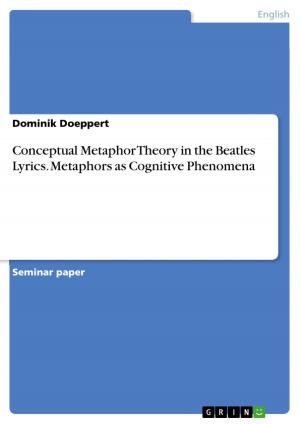| Author: | Nathalie Fiore | ISBN: | 9783668174627 |
| Publisher: | GRIN Verlag | Publication: | March 15, 2016 |
| Imprint: | GRIN Verlag | Language: | English |
| Author: | Nathalie Fiore |
| ISBN: | 9783668174627 |
| Publisher: | GRIN Verlag |
| Publication: | March 15, 2016 |
| Imprint: | GRIN Verlag |
| Language: | English |
Seminar paper from the year 2015 in the subject Literature - Canada, grade: 2,0, , language: English, abstract: The aim of this term paper is to exemplify the central key features in Postmodernism and to analyse in how far Margaret Atwood manages to make use of them in her novel 'Alias Grace'. Besides, I will concentrate on Atwood's strategies to integrate the postmodern features into the novel and to illustrate them to the reader. The first part of the term paper will be concerned with a general overview of Genette's categories of discourse-oriented Narratology and the postmodern features Fragmentation, Subjectivity, Indeterminacy and Alienation. More precisely, I will define these features and will concentrate on the most important characteristics which can be linked to the novel. I will mention Genette's Narrative Theory because it is especially important when dealing with Fragmentation. The second part will be concerned with these postmodern features with reference to 'Alias Grace'. Concerning Fragmentation, I am going to illustrate the interchanging narratives in the novel. When dealing with Subjectivity, I will analyse in how far different narratives of the story are subjective. By pointing out several passages in which open questions remain and the reader has to interpret on his own, I will discuss Indeterminacy. After doing so, I am going to point out in how far Fragmentation, Subjectivity and Indeterminacy lead to an Alienation of the reader. At the end of the term paper, a conclusion will be drawn in which one can see in how far Atwood uses postmodern elements in her novel.
Seminar paper from the year 2015 in the subject Literature - Canada, grade: 2,0, , language: English, abstract: The aim of this term paper is to exemplify the central key features in Postmodernism and to analyse in how far Margaret Atwood manages to make use of them in her novel 'Alias Grace'. Besides, I will concentrate on Atwood's strategies to integrate the postmodern features into the novel and to illustrate them to the reader. The first part of the term paper will be concerned with a general overview of Genette's categories of discourse-oriented Narratology and the postmodern features Fragmentation, Subjectivity, Indeterminacy and Alienation. More precisely, I will define these features and will concentrate on the most important characteristics which can be linked to the novel. I will mention Genette's Narrative Theory because it is especially important when dealing with Fragmentation. The second part will be concerned with these postmodern features with reference to 'Alias Grace'. Concerning Fragmentation, I am going to illustrate the interchanging narratives in the novel. When dealing with Subjectivity, I will analyse in how far different narratives of the story are subjective. By pointing out several passages in which open questions remain and the reader has to interpret on his own, I will discuss Indeterminacy. After doing so, I am going to point out in how far Fragmentation, Subjectivity and Indeterminacy lead to an Alienation of the reader. At the end of the term paper, a conclusion will be drawn in which one can see in how far Atwood uses postmodern elements in her novel.















